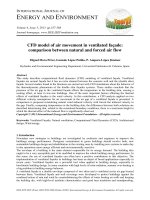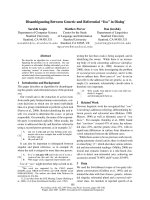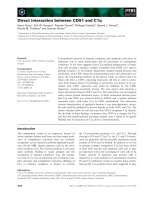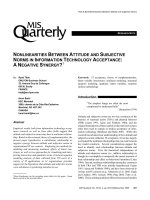Interaction between parametric and forced oscillations in multidimensional systems
Bạn đang xem bản rút gọn của tài liệu. Xem và tải ngay bản đầy đủ của tài liệu tại đây (3.39 MB, 13 trang )
Journal of Technical Physics. 16, 2, 213— 225, 1975.
Polish Academy o f Sciences. Institute o f Fundamental Technological Research, warszawa
INTERACTION BETWEEN PARAMETRIC AND FORCED OSCILLATIONS
IN MULTIDIMENSIONAL SYSTEMS
NGUYEN VAN DAO (HANOI)
This paper is devoted to the investigation of the interaction between parametric and
forced non-linear oscillations in multidimensional system described by two non-linear
differential equations of the second order. The two modes (.X, y) of the system considered
are excited by sinusoidal forces. The two modes are coupled non-linearly by means of the
product of their coordinates. Under certain conditions the oscillation of the first mode
(x) excites parametrically the oscillation of the second one and so the two oscillations of
the second mode (parametric and forced oscillations) may coexist and there exists some
kind of interaction between them.
We shall now consider the stationary oscillations of the modes and their stability.
1. Equations of Motion. Stationary Oscillations
Let us consider the oscillations of the system with two degrees of freedom described
by a set of two differentia] equations of the type
x+ / 2 ^ + £/2(/i0ir + ccc3 + cv2 x) = Osinyf,
(1 1) '
ỷ + (ư2y + eco2(hỷ + fỉy3 + bx2y) = eơ)2p cos(ví-f <5),
where h0 > 0, h > 0, a, Cy b, Q,p > 0, /?, Ổ, are constants and £ is a small parameter.
We assume the following relations between the frequencies cư,r, and y:
(1.2) cư2 = Ơ2V2 + eơ)2A , y = ev, nX # m y ,
where Ơ, e are rational numbers, A is detuming of frequencies and m, n are integers.
First, we transform the Eqs. (1.1) by means of the formulae
X = <7siny/-f ax COSỠ!,
X = yqcosyt— Aai sinfli,
0 -3 ) y — ỠCOSỚ,
ỳ = -ơrasine, q = J ĩ ị p ,
where al , ỚJ, Ơ, 6 are the new variables which will be determined later.
214 Nguyen Van Dao
Substituting (1.3) into (1.1) and transforming it, we obtain the following equations
in the standard form:
da ị
dĩ
dxp l
= EẰ(h0x + ccx3 + cy2x)sinOi ,
(1.4)
ai —J— = eXỌìqX + QLX3 -+■ cy^x )CO SỚỊ,
at
= eơv<Ị>(x,y,ỷ, 0 sinớ + 0 0 2),
at
ady
~dT
= eơv&(x, y, ỳ, t)cosd + 0(e2),
where
where
(1.5)
&(x9 y, ỳ, 0 = Ay + hỳ + bx2y + Py3 — pcos(vt+ Ỗ),
y)ị = ỚJ — At, rp = d — ơvt
Averaging the right-hand parts of (1.4) over the time, we receive the equations of the
first approximation for the unknowns a, al9y>:
1 ) for ơ # e, ơ # 1
. £//i0
-
«1.
(1.6)
n 2
eơ~vz
a =
-y-ha+
b , 3 ỡ .
2~ + 4 ^ 8
a1 = — — h^ax
(1.7)
£V
à = — ~Y [vha +/?sin(y>— ($)]+
axp =
3) for e = Ơ # 1
£T
zla + ợ2ứ + — /fa3 -p cos(y — Ô)
ỏi = ” 2 ^°ứl’
(1.8)
à = —
eơr
ơvha + - 7- a2a sin 2 w
4
£ơ
= -y r
+ ;
Interaction between parametric and forced oscillations
215
4) for e = Ơ = 1
■ EẢ u
a\ — 2~ 0ứl»
(1.9)
a — —
vha+ -^-q2asin2y)Jrpsin(y)—ỗ)\+
=
b 3 b
Aa+ ~Y q2a+ ậa3— -Ỵ q2acos2y)—pcos(y — Ô)
+
where the nonwritten terms disappear when flj = 0. By analogy with N e s s [1], the first
case is called the non-resonant case, the second case — the harmonic resonant case, the
third (1.8) — parametric resonant case and the last (1.9) — harmonic and parametric
resonant case. Obviously, the most interesting is the last resonant case. We shall inves
tigate it in more detail.
The stationary solution of the system (1.9) is the one which is determined from equa
tions = ả = ỹ) = 0 or
flj = 0,
(1.10)
r / j f l - f <72 f l s i n 2 y j + / ? s i n ( Y > — Ô) = 0 ,
Aa-\- — q2a+ pa3— Ỵ q2acos2ĩp—pcos(y-ô) = 0.
Eliminating \p in the two last equations of (1.10), we obtain the following relation for
the amplitude a = a0 = const of the stationary oscillation of the coordinate y:
(1.11) A/ = 0,
where
M = (w2 + u2 — V 2) 2 — /? 2 [ (w — acos2 <5)2 + (w*f Z>sin2<5)2],
(1.12) u = vha0, v = ~ q 2a0, IV = - a0 ỊA + q2 + ậaị
The relation (1.11) is expressed in the parameters of the initial system as
al
(1.13) -F
I - * 2 b 2 3 l\ 2,2 b1
e + 2 q + 4 H + ^ 2 - T 6 ^
1 —k2 b 3 o 2 b \ b 2 . .
- ——
h q2 + + -j-ợ2cos2<5 + I co/2 H ~ ọ sin2 Ỏ
e I 4 4 / \ 4
= 0 ,
* =
CO
Following this formula the resonant curves are presented in Figs. 1-6.
2. Stability of Stationary Oscillations
The equations in variations for the system (1.9) are
dồQỵ Ằ
[216]
Interaction between parametric and forced oscillations
217
F i g . 3.
dò
(2.1) = —(u' +v' sin2y)0)ôa—[2vcos2y)0+pcos(y0-ỏ)]ỏy,
it
a0 j — = —(w' + vfcos2y)0)ôa+[2vsin2rp0+psin(yỈQ — ỏ)]ỏy>,
where T = 2t/ev and primes denote the derivatives with respect to ŨQ. The characteristic
equation of the system (2.1) takes the form:
e+ -ị-h0)(a0Q2 + 2vha0ọ + R) = 0,
[218]
interaction between parametric and forced oscillations
219
where
(2 .2 ) R = — (u +v' sin2 ^o)[2^sin2 ^o+/7sin(^o~ Ổ)]
- ( w ' + V' COS 2\po) [ 2 v COS2 ^ 0 + p CO S(yj0 - Ô) ] .
By using the relations (1.10), (1.12), the expression R may be rewritten in the form
(2.3) R = 2 ~— 2
-
-JT— •
2(w2 + u2 — V2) oa0
As h0 > 0, h > 0, a0 > 0, the stability condition of the stationary solution is
(2.4) £ Ì ^ > 0 ,
ƠŨQ
where E = w2 + u2— V2. The resonant curves (M = 0) divide the plane (a,ky into the
regions, in each of which the expression M has a definite sign ( + or —). If moving up along
the straight line parallel to the axis a0 we pass from the region M < 0 to the region M > 0
then at the point of intersection between the straight line and the resonant curve the deriv
ative õMỊỗa0 is positive. So, this point corresponds to the stable state of oscillation if
£ = vv2*f u2—v2 > 0 and to the unstable one if £ < 0. On the contrary if we pass from
the region M > 0 to the region M < 0, then the point of intersection corresponds to
the stable state of oscillation if E < 0 and to the unstable one if E > 0.
Id the limit case when h = Ổ = 0 the equation for the stationary amplitude a0 (1.13)
may be written in the form:
/ I - * 2 3bq2 3 . 2\ 2 l ] - k 2 bq2 3 . , \ 2 p2
(2.5) + ^ r + T fit) [ ( V 1 + 4~ + 4 ft*) - j r
From here we obtain a double root
(2.6) /:2 = 1 + A sbq2 + eậaổ,
and two other roots
(2.7) = 1 + 4 - w + ị epai + ,
4 4 fl0
(2.8) p = l + 4 ^ + i - £^ _ J£
4 4 ứ 0
Following these formulae the resonant curves are presented in Figs. 1-4, where the
branch expressed by (2 .6) is shown by number 1 and the branches expressed by (2 .7)
and (2.8) are shown by numbers 3 and 4, respectively. The parameters are chosen as
(e/4)bq2 = 0.13, (3/4)e/3 = 0.1, ep = 0.1. In the shaded region (the region of parametric
resonance) the expression E = w2 + u2— V1 is negative. On the heavy lines, EdM/da0 is
positive, so that they correspond to the stable state of oscillations. The dotted lines corres
pond to the unstable state of oscillations. The signs + and — in the figures are those of
the expression M. On the branch 1 oT the resonant curves when h — 0, the stability of
stationary oscillation is doubtful because on this branch E = 0.
= 0.
220
Nguyen Van Dao
If we take into account a small value of friction h (h > 0) the resonant curves have
the form shown in Figs. 5, 6, where v2h2 = 0.005. These curves are obtained by solving
the Eq. (1.13) on a digital computer. The branch 1 in the case of h = 0 (Figs. 1-4) changes
into two either stable (Fig. 6) or unstable branches (Fig. 5). With larger values of friction
(h) the resonant curves take the forms presented in Fig. 7 (v2h2 = 0.01) and Fig. 8 (v2h2
= 0.02).
From the results obtained the following conclusions may be drawn:
1) Inside the region of the parametric resonance, the parametric excitation caused
by the first mode (x) strongly influences the stability of the stationary forced oscillations
of the second mode (j>). Some branches of the resonant curves of the second mode oo
which are unstable for X = 0 now become stable and * vice versa. Outside the region of
the parametric resonance, the mechanism of parametric excitation does not influence the
stability of the forced oscillations.
2) The jump phenomenon of the amplitudes — in the case of a hardening character
istic (Fie. 1, 5), when the frequency k decreases, and in the case of a softening character
istic (Fies. 4,6), when the frequency increases — is observed quite clearly. The change
of the stationary amplitudes follows the M-form.
We assume now that the amplitude of the external force acting on the second mode
(v) is not small, so that the equations of motion take the form
where V ^ cư.
On the assumption that there are resonant relations (1.2), we first transform the Eqs.
(3.1) by means of the formulae:
3. System with a Large Amplitude of the External Force
(3.1)
x + ?.2X+ e?.2(h0x+ ccx3 + cy2x) = Qsinyt,
ỷ+ơ)2y+eoj2(hỳ+fìy2 + bx2y) = Z)cos(r/+ (5),
(3.2)
X = qsiuyt + a1 COSỠj ,
X = yq cos y t — Áũ 1 sin 6!,
y = jcos0 + c/cos(vr + <5),
(3.3)
(X)2—V2 r2 (ơ2 — 1)
The equations for new variables a1,61, a,6 are
(3 .4 )
aixpl = £Ẳ(/20i:+ ttx*+ cy2x)cosO I,
à =* CƠT0! (*,}>, ỷ) sin 0 + ơ(£2),
axp = £ ơ r0 i( x , j,ỷ )c o s ớ -f ỡ (£ 2),
(x, y, ỳ) = Ay + hỷ+Py3+ bx1y ì y>ị = ỚỊ — Ằí, y = 6 — ơvt.
[2211
222
Nguyen Van Dao
By averaging the right-hand sides of (3.4) over the time, we obtain,
1) for Ơ = e = 3 (superharmonic and parametric resonance)
SẰ'
A0fli,
<3.5) à = 3r»'
3 8 1
— I- r/ĩứ + i/ 3 sin (y) — 3 Ổ) — bq2a sin 2^
2 o o
ay = 3ev { — fl-f p
3 3 <f3
J3 + 0— cos (y* — 3 Ổ)
o 4 o
* 2 * 2
4- — q a— — qzaoosl\p
2) for Ơ = 3, e = 2 (superharmonic and combination resonance)
• _ EĨ'2 u
ai —
2— °Ơ1 ’
— \ - v h a + 4 -/ W 3sin(Y> —3 Ổ )- <7 2*/sin(y>+<5)
1 o o
aỳ) = 3er +/5
3 3 d3
q Q3jt -r-d2a+ ~~ cos(yj-3<5)
o 4 o
-Ỵ ^ 2a - - Ỵ ^ dcos^ + *)Ị
+ ỡ(«i);
3) for Ơ = 3, e = 1 (superharmonic and combination resonance)
e?.2
a, = -
h0Qi *
<3.7)
à — 3er
3 8 h
— vha + — d3 sin (v> - 3 Ổ) — q2d sin (V - Ổ)
X o o
dip = 3ei> |- y -
— -3- q2dcos{xp-<5)> + 0{a^)\
4) for ơ = -ị-, e = -i- (subharmonic-parametric and combination resonance)
a, = -
h0ait
E V ị V 3 z? I
<3.8)  = -y-j — -^-/ỉj+-ị-^íÌ72sÌD(3v>—ổ)“ -~ ợ 2[ữsin2^ + í/sin(^— +
. _ ev ị Aa
3 2 +i>
3 3 3
-5- Ữ3 + -7- í/2ữ -f -5- dtf 2cos(3y> — (5)
8 4 8
+ -7-qa
q2[acos2y) + dcos(y— (5)]? -f 0{al)\
Interaction between parametric and forced oscillations
223
1 2
5) for Ơ = - y , e = — (subharmonic and combination resonance)
• _ _ £*2 u
a\ — 2 hoai>
(3.9)
ay
- -y- [ — -^r ha + ^-fida2 sin(3y>—<5) — ^ q zdún(\p+ Ô) + 0(aL),
= y + y Jơ2 cos(3y>-ổ) +
- -^-q2d cos(y> + <5)1 + 0 0 !);
6) for Ơ = 3, e # 1,2,3. (superharmonic resonance)
• _ £*2 u
a\ = - —TT-noũỵ,
(3.10) à = 3ev
= 3ev I
+ 0(a x),
3 3 d3
ơ3 + - J í / 2ứ + ~-cos(y> —3Ổ)
o 4 o
1 1 2
7) for Ơ = -J, e # 3 ’ 3 (su^ armon*c resonance)
(3.11) ả =
<2^
£T
£T'
— 2- ha + — pda2 sin(3v> — Ô)
6 o
I Aa , o
p r + i
ị a 3+ - ị + cos(3w — Ỏ)
8 4 8
+ ^ a j + OOJ;
8) for ơ = e # ^ > 3 (parametric resonance)
• _ e/'2 u
ài = h0aJ ,
(3.12) à = eơr
= £ƠT
— /lứ— g"#2^ sin2y^
+ 0(ứi)>
/ 3 3 3 \ * 2 è 2
4-P Ị — a3+ — d2a I + — — q2a cos2yj
9) for 2e — ơ— 1 = 0, e # 2, -J- (combination resonance)
SẢ2
h o ^i»
224
Nguyen Van Dao
(3.13) à = eơv
axp = eơv
- ~ h a - — q2d sin(v> + ô)
Aa
+ /ỉ Ị -jp ữ 3 + d2a + -T- q2a - qzd COS(yi + ô)
10) for ơ— 1 = ±2e, e -Ỵ, 1 (combination resonance)
• _ £^2 i,
aì ^ M l,
(3.14) ứ = £ƠT
= eơv
- ^ h a - — q2d$m(y-ồ) +0(al)9
Aa /> / 3 - 3 , \ è , Ề ,
2 + M 8 4 ) + 4 ? 8 9 C0S(V-<5)
1 1 ) for non-resonant case
ơ 7^ 3, ơ ^ 3 ’ Ơ # e, 2e — Ơ ± 1 ^ 0, 2e-fơ — 1 = 7 * 0 ,
• - e^2 í,
0\ ~ ^ "0ữi >
(3.15)
á = - -L (<Tv)2/ia + 0(ai),
a x p — e ơ v
Aa * 1 3 3 3 ^ 2 \ * •> ’
2 + ^\8 ữ + 4 ^ ứ)+ 4
The analysis of the systems (3.8) and (3.9) is rather complicated. The system (3.5)
has been investigated exhaustively in the previous paragraph. As the study of the remain
ing systems is not difficult we shall not consider them here.
References
1. D. J. N es s, Resonance classification in a cubic system, A SM E A pplied Mechanics Conference 1971.
2. N. N. B o g o lĩ ƯBOV, Yu. A. M itr o p o ls k y , Asymptotic methods in theory o f non-linear oscillations,
Moscow 1963.
Streszczenie
ODDZIALYWAN1E MIẸDZY DRGANIAMI PARAMETRYCZNYMI
I WYMUSZONYMI w WIELOWYMIAROWYCH ƯKLADACH
Niniejszy artykuỉ zostal poswiẹcony badaniu oddziatywan miẹdzy drganiam i param etrycznyrai i wy-
muszonymi w wielowymiarowych ukJadach, które opisywane sạ przez ukỉad dwoch n ie lin io w y ch rốz-
niczkowych row nan drugiego rzẹdụ (1.1). Obie Dormalne wspỏhzẹdne (x ,y ) sạ w zbudzane przez sity
harm oniczne. Dwie w spomniane wspóỉrzẹdne sạ zwiạzane z sobạ przez ich iloczyn.
Interaction between parametric and forced oscillations
225
Przy okreslonych warunkach drgania picrwszej wspóỉrzẹdnẹj (*) parametrycznie wzbudzaja drgania
drugiej wspofrz^dnej (>>), a wiẹc oba drgania: param etrvczne i wymuszone drugiej wspótrzẹdnej mogạ
vvspóỉistniec i miẹdzy nimi ma miejsce pewien rodzaj oddzialywania. Zbad ano stacjonam e drgania vvspól-
rzẹdnych oraz ich statecznosc.
p e 3 JO M c
B3AHMOJXEHCTBHB ME X & y riA PAM ETPH ^ECKHM H H BBIHy>K£EHHfeIMH
KOJIEEAHHtfMH B MHOrOMEPHLIX CHCTEMAX
HacTOHiuan crraTLH nocBHmeHa HCCJieaoBaHHK) B3aHM0fleHCTBHH Me>KjỊy napawcTpHqecKHMH H Bbi-
Hy>KfleHHI>IMH KOilCÕaHHHMH B MHOrOMCpHblX CHCTeMaX, KOTOpbie OnHCblBaiOTCH CHCTeMOÌÍ ỊỊBỴX HeJIHHCH-
Hbix ZỊHỘ(ị)epeHLỉHajn>Hbix ypaBHeHHM BToporo nopHjxKa (1.1). Oõe HopMajn»Hi»ie KoopflHHaTbi (x , y )
B030y>KIiai0TCH rapMOHHHeCKHMH CHJiaMH. UBe VKa3aHHbie KOOpflHHaTbl CBH3âHbI MOKJ^V COÕOH hx
npoH3BefleHHeM.
npH onpeziejicHHBix ycjioBHHX KOJie6aHHH nepBOH KOopxtHHaTbi (x ) napaMeTpifqecKH B03ỗy>KiỊaK)T
KOJieõaHHH BTopoỉí KoopflHHaTbi (y ) H J cneflOBaTeJibHOj oốa KOJieõaHHH: napaMiTpirqecKHe H Bfemy>K-
neHHbie BTOpOÌÍ KOOpAHHaTbl MOryT COCymCCTBOBaTt H MOKiỊV HHMH HMeeTCH HeKOTOpbm BHU B33HM0-
HeỉÌCTBHH. BblJIH HCCJIC^OBaHbl CTailHOHapHbie KOJieOaHHH KOOpjIHHaT H HX VCTOifMHBOCTb.
d e p a r t m e n t o f m a t h e m a t ic s an d ph y s ic s
POLYTECHN]cAL INSTITUTE, HANOI
Received October 14, 1974.









